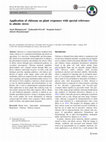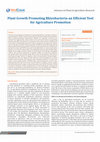Videos by Deepmala Katiyar
Cell Signaling Introduction (Part-1) | Types of Cell Signaling | Paracrine | Juxtracrine | Endocr... more Cell Signaling Introduction (Part-1) | Types of Cell Signaling | Paracrine | Juxtracrine | Endocrine Signaling
Connect Learn Explore
https://youtu.be/eH71upXOpMY
In this lecture we have described cell signaling introduction and types of signaling. This complete video will help many students who are CSIR- NET/JRF, ARS-NET, GATE- XL, GATE-BT, DBT- BET/JRF, aspirants and also beneficial to M.Sc., B.Sc. students. For this purpose to be fulfilled various books, review and research papers have been consulted. Books like Molecular cell biology by Lodish, Molecular Biology of Cell by Albert and The cell : A molecular Approach 3rd Ed. by Cooper Geoffrey. All flow charts and diagrams in every video were self created by the creators (mentioning the source) thus all matters have been re-synthesized. Vigyan Sarovar positively aims to provide free knowledge, education, content and guideline to budding scientist.
Thanks for your all support!! 5 views
Papers by Deepmala Katiyar

The present investigations were carried out to assess the extent of cadmium stress-induced morpho... more The present investigations were carried out to assess the extent of cadmium stress-induced morpho-physiological responses in mungbean (Vigna radiata L.) genotype HUM-1 and its mitigation in the presence of plant growth regulators salicylic acid (SA) and paclobutrazol (PBZ), at different growth stages. All the treatments resulted in improvement of plant growth characteristics viz. germination percentage, root length, plant height, leaf numbers, leaf area, total dry weight. The germination percentage was found to be significantly enhanced with PBZ application @ 50μM. Highest root length was observed with PBZ application at 50μM with both the levels of Cd stress; 75 μM (C1T1) and 150 μM CdSO4(C2T1).The plant height was found to be significantly enhanced with PBZ treatment @ 100 μM, with 150 μM CdSO4 (C2T2). A reduction in both number of leaves and leaf area was observed in plants which were exposed to Cd stress. The dry weight seen in the light of the comparative better performance of ...

An experiment was conducted to find out the response micronutrients application on morphological,... more An experiment was conducted to find out the response micronutrients application on morphological, biochemical attributes in variety Punjab chhuhara of Tomato. The treatments consisted of boron, iron, combination and control. All the treatments resulted in improvement of plant growth characteristics viz. plant height, Total leaf area, Total dry matter yield, net assimilation rate chlorophyll content total carotenoids, total protein, sugar content, nitrate reductase activity, and proline content in the variety. Growth, biochemical parameters and yield attributes of tomato was significantly improved by the application of boron and iron either individually or in combination up to different concentrations. The plant height was found to be significantly reduced under depleted iron combined with higher boron (50 mM). NR activity and toatal sugar content increases with increase in boron concentration with different iron levels. The treatment records maximum value for total sugar at pre-flow...
International journal of pharma and bio sciences, 2015

Journal of Plant Physiology & Pathology, 2017
Application of Plant Growth Promoting Rhizobacteria in Promising Agriculture: An Appraisal Gradua... more Application of Plant Growth Promoting Rhizobacteria in Promising Agriculture: An Appraisal Gradually agriculture is facing struggle to meet the various threaten of producing more food for an increasing world population food security. Large quantities of synthetic fertilizers and pesticides are necessitated for high productivity which can smash up bionetwork structures and functions, including the soil microbial community which plays imperative function in agriculture sustainability. Soil is an excellent niche of growth of many bacteria in rhizosphere. Many rhizospheric bacterial strains possess plant growth-promoting mechanisms. These bacteria can be applied as biofertilizers in agriculture and forestry, enhancing crop yields. Plant growthpromoting rhizobacteria can improve plant growth through several different mechanisms: (a) the synthesis of plant nutrients or phytohormones (Indole acetic acid and cytokinin), which can be uptake by plants, (b) the mobilization of soil compounds like phosphorous and metals, making them available for the plant to be used as nutrients, (c) the protection of plants under stressful conditions, thereby counteracting the negative impacts of stress, or (d) defense against phytopathogens, reducing plant diseases or death by producing antibiotics and HCN. Several plant growth-promoting rhizobacteria have been used worldwide as biofertilizers, contributing to increasing crop yields and soil fertility and hence having the potential to contribute to more sustainable agriculture and forestry. Scientific researchers involve various moves towards for identification of plant growthpromoting rhizobacteria adaptation, upshot on physiological and growth aspects on plants and induced systemic resistance, biocontrol and biofertilization in agriculture.

Physiology and Molecular Biology of Plants, 2019
Chitosan is a natural biopolymer modified from chitins which act as a potential biostimulant and ... more Chitosan is a natural biopolymer modified from chitins which act as a potential biostimulant and elicitor in agriculture. It is non-toxic, biodegradable and biocompatible which favors potentially broad application. It enhances the physiological response and mitigates the adverse effect of abiotic stresses through stress transduction pathway via secondary messenger(s). Chitosan treatment stimulates photosynthetic rate, stomatal closure through ABA synthesis; enhances antioxidant enzymes via nitric oxide and hydrogen peroxide signaling pathways, and induces production of organic acids, sugars, amino acids and other metabolites which are required for the osmotic adjustment, stress signaling, and energy metabolism under stresses. It is also known to form complexes with heavy metals and used as tool for phytoremediation and bioremediation of soil. Besides, this is used as antitranspirant compound through foliar application in many plants thus reducing water use and ensures protection from other negative effects. Based on such beneficial properties, chitosan is utilized in sustainable agricultural practices owing to changing climates. Our review gathers the recent information on chitosan centered upon the abiotic stress responses which could be useful in future crop improvement programs.
THE JOURNAL OF PLANT SCIENCE RESEARCH, 2018

Agricultural Science Digest - A Research Journal, 2017
The present investigation was carried out to examine the role of exogenously applied ascorbic aci... more The present investigation was carried out to examine the role of exogenously applied ascorbic acid which mitigates the deleterious effects of salt stress in mungbean (Vigna radiata L.) genotype HUM-1. Plants grown under induced salinity stress at 150 mM NaCl were treated with different concentration of ascorbic acid, i.e., 0.5 mM, 1.0 mM and 2.0 mM. To study the effects of treatments of salt stress on chlorophyll content, proline content, nitrate reductase activity, superoxide dismutase activity and yield attributes data were recorded at 20, 40, 60 day after sowing. Nitrate reductase activity and chlorophyll content with 1.0 mM ascorbic acid under salinity (150 mM NaCl) while the activities of superoxide dismutase get reduced up to 43.71% at 40 days after sowing. In plant treated with combined treatment of 150 mM NaCl and 1.0 mM foliar applied ascorbic acid caused a decline in the level of proline, which was 3.38 mg, 3.35 mg and 6.30 mg at 20, 40 and 60 days after sowing. The thresh...

Advances in Plants & Agriculture Research, 2016
Current soil management strategies are mainly dependent on inorganic chemicalbased fertilizers, w... more Current soil management strategies are mainly dependent on inorganic chemicalbased fertilizers, which caused a serious threat to human health and environment. Plant growth-promoting rhizobacteria (PGPR) are naturally occurring soil bacteria that aggressively colonize plant roots and benefit plants by providing growth promotion. Inoculation of crop plants with certain strains of PGPR at an early stage of development improves biomass production through direct effects on root and shoots growth. The major groups of PGPR can be found along with the phyla actinobacteria, bacteroidetes, firmicutes, and proteobacteria. Inoculation of agricultural crops with PGPR may result in multiple effects on early-season plant growth, as seen in the enhancement of seedling germination, plant health, vigor, height, shoot weight, nutrient content of shoot tissues, early bloom, chlorophyll content, and increased nodulation in legumes. PGPRs are reported to influence the growth, yield, and nutrient uptake by an array of mechanisms. They help in increasing nitrogen fixation in legumes, help in promoting free-living nitrogenfixing bacteria, increase supply of other nutrients, such as phosphorus, iron and produce plant hormones that enhance other beneficial bacteria or fungi. Now a day's an increasing number of PGPR being commercialized for various crops. Subsequently, there has been much research interest in PGPRs. Several reviews have discussed specific aspects of growth promotion by PGPRs. Therefore, PGPRs can help to generate wealth cooperatively in local communities, reducing the need for more expensive manufactured products, such as nitrogenous fertilizers and use of PGPR in world has the potential to provide valuable insight.
African journal of microbiology research
The increas increased s bacteria ha three com officinalis) different pa Escherichia carandas f ag... more The increas increased s bacteria ha three com officinalis) different pa Escherichia carandas f against E. showed str Mentha arv 0139). An in organism. T extracts an promising f
Study on effect of natural gas flaring (light pollution) on soil health/environment of paddy fiel... more Study on effect of natural gas flaring (light pollution) on soil health/environment of paddy field of Assam near the vicinity of oil wells under oil India limited-B. Kalita, H.P. Sharma and S.
Journal of Pure and Applied Microbiology
ABSTRACT
Journal of Pure and Applied Microbiology
ABSTRACT
Journal of Pure and Applied Microbiology
ABSTRACT

Asian Journal of Microbiology, Biotechnology and Environmental Sciences
Variation in methane oxidizing bacterial population size due to rice varieties was investigated d... more Variation in methane oxidizing bacterial population size due to rice varieties was investigated during July-November 2009 in irrigated rice varieties NDR-80, Pant Dhan-10 and Sarjoo-52. Bare, bulk and Rhizospheric were sampled for the analysis of NO 3 -N, NH 4 -N and MOB population for each variety. The observations were made during 20 to 120 days after transplantation (DAT). The fertilizer selected for the experiment was urea and was applied in three split doses (40:30:30 Kg Nha -1 ) to all rice varieties. The experimental design was consist of: (a) Bare 6 plots (3 plots unvegetated, 3 unfertilized plots), (b) Bare fertilized (3 replicate plots for each unvegetated) (c) vegetated plots for each variety (9 plots, 3 replicates for each variety unfertilized) and (d) vegetated fertilized (9 plots, 3 replicate plots for each variety). Results showed that there was significant difference in growth variables for all rice varieties due to growth period and fertilization. The ammonium -N and nitrate-N was higher in fertilized plots than unfertilized plots. Among varieties Pant Dhan-10 had maximum ammonium -N, nitrate-N followed by NDR-80 and Sarjoo-52. The MOB population higher in unfertilized and fertilized plots from 80-120 DAT across soil type (Bare, Bulk and Rhizosphere) of all varieties. The MOB population range from 3.1 to 60.1 × 10 6

Indian Journal of Plant Physiology, 2015
Biopolymer ''Chitosan'' has received much interest for potential wide application in agriculture ... more Biopolymer ''Chitosan'' has received much interest for potential wide application in agriculture due to its excellent biocompatibility, biodegradability and bioactivity. This naturally occurring molecule with interesting physiological potential has been getting more attention in recent years. Chitosan enhanced the efficacy of plants to reduce the deleterious effect of unfavorable conditions as well as on plant growth. Chitosan affects various physiological responses like plant immunity, defense mechanisms involving various enzymes such as, phenylalanine ammonium lyase, polyphenol oxidase, tyrosine ammonia lyase and antioxidant enzymes viz., activities superoxide dismutase, catalase and peroxide against adverse conditions. Recent studies have shown that chitosan induces mechanisms in plants against various biotic (fungi, bacteria, and insects) and abiotic (salinity, drought, heavy metal and cold) stresses and helps in formation of barriers that enhances plant's productivity. This paper takes a closer look at the physiological responses of chitosan molecule.

Advances in Plants & Agriculture Research, 2014
The rising ambient temperature by plant cells is crucial for the timely activation of various mol... more The rising ambient temperature by plant cells is crucial for the timely activation of various molecular defences before the appearance of heat damage. The heat-threshold level varies considerably at different developmental stages. With a view to survive under heat stress, mechanisms of regulation at the molecular level enable plants to prosper. Traditional breeding contributed for improving heat tolerance meagrely. The genetic transformation approach needs to be accelerated that can mitigate harmful effects by developing improved thermotolerance of crop plants. In this background, a thorough understanding of physiological responses of plants to high temperature, mechanisms of heat tolerance and possible strategies is vital. Temperature changes are sensed through cellular responses due to signal transduction into the cell. A key ingredient for plants temperature sensing ability is a specialized histone protein, dubbed H2A.Z that wraps DNA into a more tightly packed structure. Further, metabolic reactions and internal conductance to CO 2 decrease Rubisco activation, inhibition of Rubisco activase and subsequently slowing down net photosynthesis (Pn). Importance of internal conductance to CO 2 , heat inducible transcription factor for heat shock response (HSR) involve different HSR genes. The mechanisms, which are regulated at the molecular level, facilitate plants to thrive under heat stress. Exogenous applications of protectants such as osmoprotectants, phytohormones, signaling molecules, trace elements etc. have shown beneficial effects on plants growing under high temperature, due to the growth promoting and antioxidant activities of these compounds. There is acute necessity of crop biotechnology research for evolving genetically modified (GM) crops for a high CO 2 world at this juncture. So, attaining thermotolerance is a lively process to escape damages caused by heat stress.
Indian Journal of Scientific …, 2010
Diatoms (Bacillariophyceae) are microscopic unicellular algae found in every aquatic habitat and ... more Diatoms (Bacillariophyceae) are microscopic unicellular algae found in every aquatic habitat and contribute a large percentage of global carbon budgets through photosynthesis. A study was conducted to assess the effect of phosphate concentration on diatom growth. The ...
Asian Journal of Agricultural Research, 2012








Uploads
Videos by Deepmala Katiyar
Connect Learn Explore
https://youtu.be/eH71upXOpMY
In this lecture we have described cell signaling introduction and types of signaling. This complete video will help many students who are CSIR- NET/JRF, ARS-NET, GATE- XL, GATE-BT, DBT- BET/JRF, aspirants and also beneficial to M.Sc., B.Sc. students. For this purpose to be fulfilled various books, review and research papers have been consulted. Books like Molecular cell biology by Lodish, Molecular Biology of Cell by Albert and The cell : A molecular Approach 3rd Ed. by Cooper Geoffrey. All flow charts and diagrams in every video were self created by the creators (mentioning the source) thus all matters have been re-synthesized. Vigyan Sarovar positively aims to provide free knowledge, education, content and guideline to budding scientist.
Thanks for your all support!!
Papers by Deepmala Katiyar
Connect Learn Explore
https://youtu.be/eH71upXOpMY
In this lecture we have described cell signaling introduction and types of signaling. This complete video will help many students who are CSIR- NET/JRF, ARS-NET, GATE- XL, GATE-BT, DBT- BET/JRF, aspirants and also beneficial to M.Sc., B.Sc. students. For this purpose to be fulfilled various books, review and research papers have been consulted. Books like Molecular cell biology by Lodish, Molecular Biology of Cell by Albert and The cell : A molecular Approach 3rd Ed. by Cooper Geoffrey. All flow charts and diagrams in every video were self created by the creators (mentioning the source) thus all matters have been re-synthesized. Vigyan Sarovar positively aims to provide free knowledge, education, content and guideline to budding scientist.
Thanks for your all support!!